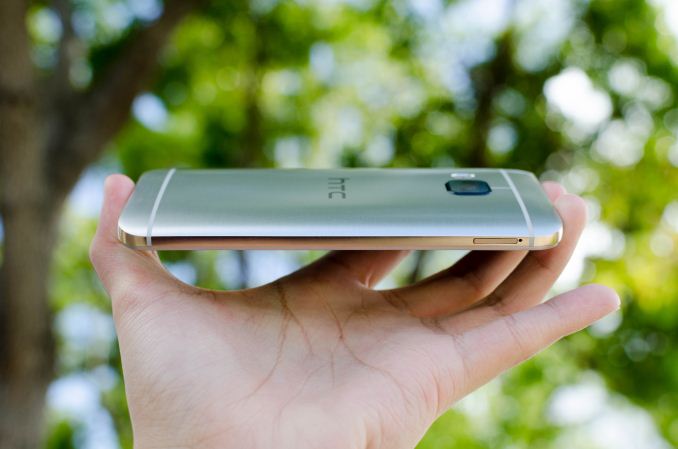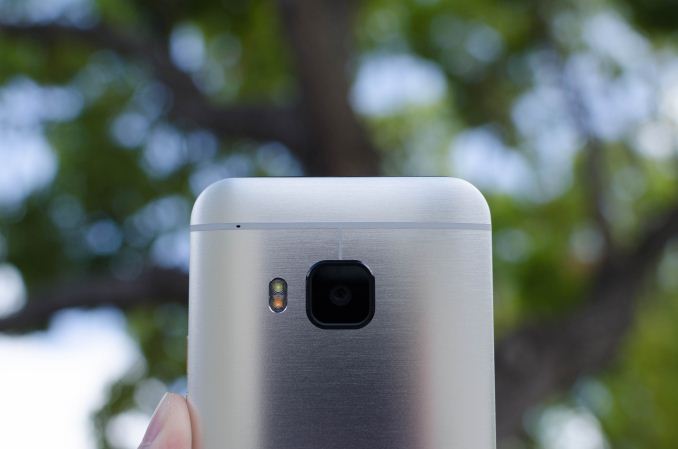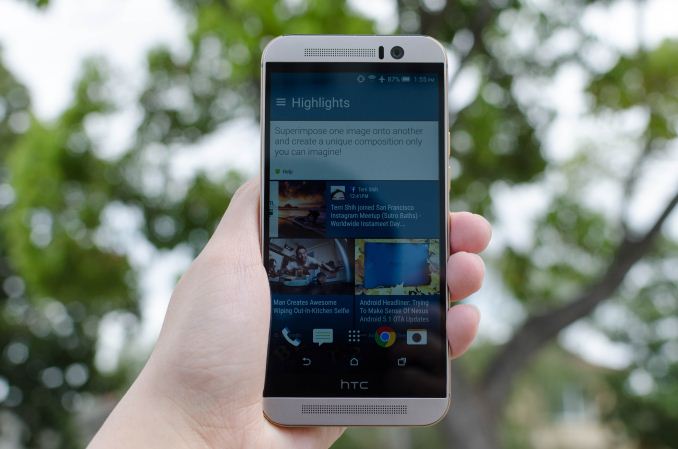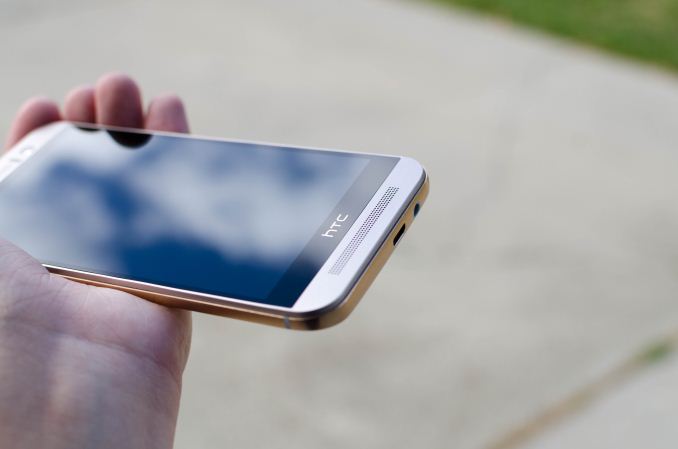The HTC One M9 Review: Part 1
by Joshua Ho on March 22, 2015 7:00 PM EST- Posted in
- Smartphones
- HTC
- Qualcomm
- Mobile
- Snapdragon 810
- One M9
Initial Conclusions
Overall, the One M9 is a pretty significant device for HTC and really sets the tone for the entire year, so it’s well worth going over everything again before we draw any conclusions about the One M9. However, any of these initial thoughts will be limited in their scope because it isn’t really possible to characterize HTC’s camera performance, nor the performance of Snapdragon 810 under load at this time due to HTC's last-minute software update. We can only really look at some key areas like the display, battery life, and SoC performance, along with design and software.
To start, HTC has done a decent job of refreshing the One design for the M9 with their new brushed finish and dual anodization process. HTC has also finally moved the power button to the right side of the phone, and improved the fit and finish of the plastic front bezel. However, there are a lot of missing details that one might have expected from a refinement of a previous design. The power button on the side ends up a bit too low for most people as far as I can tell, and ends up being rather easy to accidentally press and is also being difficult to press intentionally. The volume buttons are also easily confused for the power button, even with the textured pattern on the power button to avoid confusion. The back cover does have a nice feel, but the hard edge between the back and sides of the phone is just too sharp for everyday use and the front bezel is too far separated from the back cover to really make sense. It’s obvious that the bezel on the front of the phone can’t be eliminated, but the arrangement of the bezel combined with on screen buttons really affects the ergonomics of the device. The M7’s keyboard feels comfortably placed in comparison to the M8 and M9, which seem too tall for comfortable typing.
SoC performance is a mild improvement over Snapdragon 805, and a significant improvement in GPU over Snapdragon 801. However, it’s definitely alarming at how small the differences are when Snapdragon 810 is placed in a phone, and it seems that the thermal output of the Snapdragon 810 is high enough that sustained tests end up placing it somewhere around the range of the Snapdragon 805 in CPU-bound tests. In GPU performance, the improvements over the Snapdragon 805’s Adreno 420 are generally somewhat minimal, which really justifies HTC’s decision to go with a 1080p display for the M9.
Unfortunately, in battery life HTC manages to fall somewhat flat as the combination of the Snapdragon 810 and the loss of panel self-refresh causes a significant regression in battery life despite the increase in battery size. I’m not sure how much HTC could’ve done to prevent this, but the removal of PSR is definitely something HTC could’ve kept to try and keep battery life similar to the One M8. This is really the first generation to my memory that actually regressed on battery life in our benchmarks, which is concerning for any device with a Snapdragon 810 SoC. It may be that this is just HTC’s problem, but given that HTC has generally managed to do well at extracting maximum battery efficiency from previous platforms I’m not sure if other OEMs will be able to improve the situation here.
The display is one of the more disappointing aspects of the One M9 thus far. Although the 1080p resolution isn’t really a problem in actual use, the lack of improvement or regression in every other metric suggests that HTC has gone backwards in display quality. Combined with the removal of PSR, it’s concerning to see that cost optimization has affected such a crucial aspect of the smartphone experience. Overall, even when comparing against 2014 smartphones the One M9 ends up closer to the bottom for display quality.
The software experience seems to be one area where HTC continues to do relatively well compared to most Android OEMs, and Sense 7 remains a relatively enjoyable experience. However, the new additions to Sense 7 aren’t really all that helpful. There’s a lot of effort spent on introducing new features like additional personalization and some new widgets and applications, but none of this really feels well-differentiated, and there isn’t much change to the rest of the UI to make it mesh with Lollipop’s UI. It also seems that Snapdragon 810 causes some minor performance issues, but the effects of this are incredibly minor and it’s hard to tell whether this is due to random variance to some extent.
Although we’re still missing some of the pieces, based upon what data we have the One M9 is in an alarming place for a new smartphone. It’s pretty rare that a new phone ends up regressing in almost every major way compared to an old phone, but the One M9 ends up doing this in display and battery life. The SoC is better, but I can’t help but feel that Snapdragon 805 ends up being a better choice than Snapdragon 810 for a flagship smartphone at this time. The Snapdragon 808 may be better suited as an upgrade to the Snapdragon 805, but given the performance of the 810 I’m not really holding my breath. Given all of these issues, I’m almost tempted to point to the One M8 as the better phone, but until we get the full picture we won’t be coming to any final conclusions about the One M9.
















132 Comments
View All Comments
Snark Attack - Sunday, March 22, 2015 - link
while while while while while while whileSeriously Josh, you need to stop abusing that word. I've seen multiple instances of starting two sentences with while in several of your reviews. It's getting pretty tedious. I bet if I were to ctrl-f in other reviewer's articles, there will be significantly fewer matches.
Thanks for the review.
JoshHo - Sunday, March 22, 2015 - link
While abuse has been alleviated to some extent, thanks for the feedback.FunBunny2 - Monday, March 23, 2015 - link
of course, my textual abuse is somewhat, of course, less lethal.TedKord - Monday, March 23, 2015 - link
It's always sad to see someone addicted to abusing a word. There is help out there, but the first step is admitting you have a problem, and wanting to be helped.Just say "NO". (But not too often, or you could get hooked on it)
Quidam67 - Monday, March 23, 2015 - link
I enjoy reading the comments section for anandtech reviews because they attract a higher; more educated form of whiny b!tches.jjj - Sunday, March 22, 2015 - link
Any ETA for more on SD810? At least a vague range.Anyway, guess not much to say here, it's all bad. Maybe a drastic price cut would change the picture.
testbug00 - Monday, March 23, 2015 - link
What's the problem with the 810? It behaves exactly how an SoC that draws at least 7W running only the CPU at max clocks would...peterfares - Sunday, March 22, 2015 - link
HTC done messed upcandrews74 - Sunday, March 22, 2015 - link
I wonder if the issues with software are something that running a different OS would solve. I have two M8s one with Android and the other with Windows Phone 8.1 and the Windows phone version gets better battery life by about 24 hours in standby. When I use it for testing web sites, the Windows version also last longer and supports more JavaScript features than Chrome, its almost scary compared to desktop IE.I guess we will see if MSFT makes good on their promise that any Android phone can run Windows Phone 10 and see what this thing can do.
sprockkets - Sunday, March 22, 2015 - link
Interesting, yet arstechnica found that the power save mode on the android version beats the windows version. YMMV.